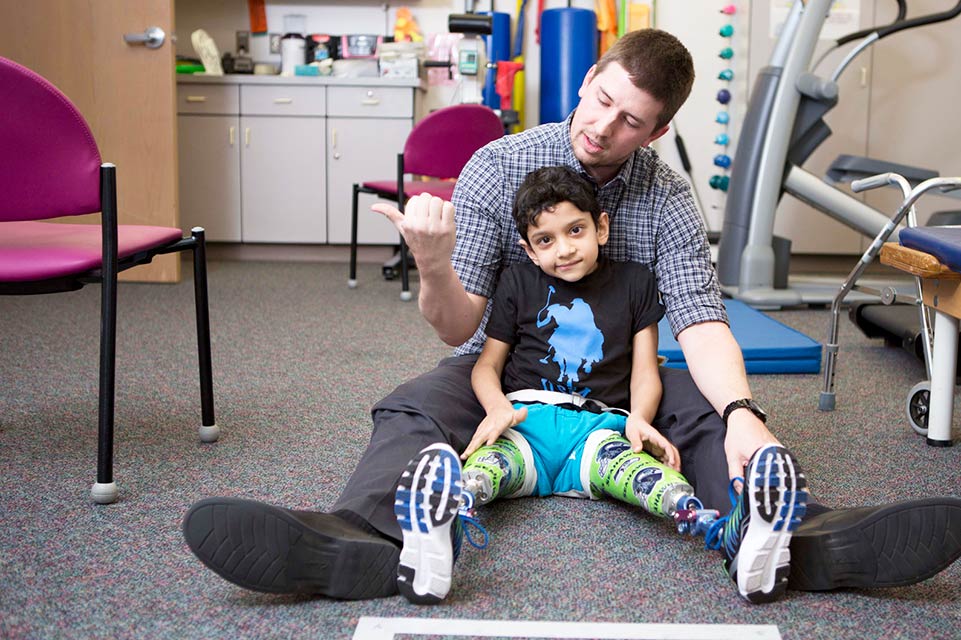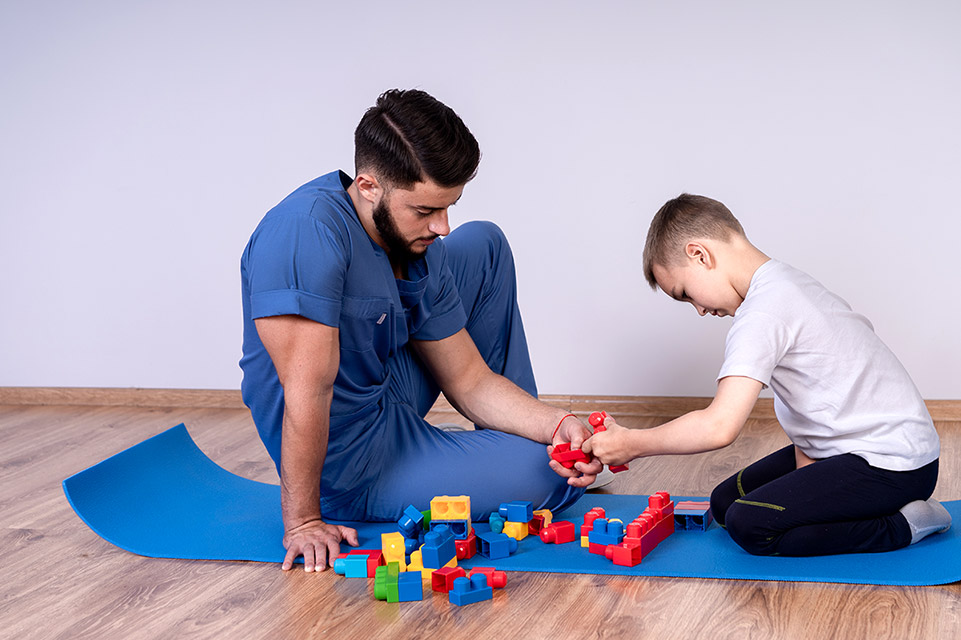Neurofibromatosis
Our skilled team helps you manage a complex genetic condition.
Neurofibromatosis type 1 is a genetic disorder that causes tumors to form on your child's nerve tissue. These tumors can develop anywhere in the nervous system, including the brain, spinal cord and nerves.
The tumors are usually not cancer, and your child's symptoms might be mild. However, it is extremely important to bring your child to a physician to monitor them for complications that can develop as they grow, including hearing loss, learning impairment, heart and blood vessel problems, loss of vision and severe pain.
Neurofibromatosis occurs in about one in 3000 people. Around half of children with neurofibromatosis inherited it from a parent. The other half has it due to a new genetic change.
Shriners Children's physicians have experience helping children with neurofibromatosis. Diagnosing the condition starts with a detailed review of your child's medical and family history. Genetic testing may help pinpoint the issue and assist other family members who may be affected.
Our physicians typically see neurofibromatosis in children ages 3 to 16, though more severe cases often arise in infants. We focus on treating kids with neurofibromatosis by encouraging healthy growth and development early on and managing complications should they appear.
Specific treatments and services may vary by location. Please contact a specific location for more information.
Causes of Neurofibromatosis
Neurofibromatosis is caused by a genetic mutation that is either passed on by a parent or occurs at conception.
Approximately 50% of children with neurofibromatosis inherited an altered copy of the nf1 gene from a parent who also has neurofibromatosis. In the remaining 50% of children, neurofibromatosis came from the development of a new mutation in the nf1 gene in the father’s sperm, mother’s eggs or in a cell of the developing baby. In these cases, the child will be the first one in their family to carry this genetic change.
People who carry an altered nf1 gene in their cells have a 1-in-2 chance of passing the condition on to their children. Kids who inherit the altered gene copy will have neurofibromatosis and will be at risk of developing complications.
Signs and Symptoms
The most common signs and symptoms of neurofibromatosis include:
- Flat, light brown spots on your child's skin: These harmless spots are common in many people. Having more than six might be a sign of neurofibromatosis. They are usually present at birth or appear before your child turns 1.
- Freckling in the armpits or groin area: This typically appears by ages 3 to 5. The freckles are smaller than those mentioned above and tend to occur in clusters.
- Tiny bumps on the iris of the eye: You won't be able to easily see these harmless nodules. They don't affect your child's vision.
- Soft, pea-sized bumps on or under the skin: These tumors are not cancerous. They usually develop in or under the skin, but they can grow inside the body. If they occur on your child's face, they can be disfiguring. These may increase in number as your child gets older.
- Bone deformities: You might notice your child's spine curves. This is a sign of scoliosis. You also might notice your child's lower leg appears bowed. This is because, with neurofibromatosis, your child's bones are not as dense.
- Tumor on the optic nerve: These tumors usually appear by age 3.
- Learning disabilities: Impaired thinking skills are common in children who have neurofibromatosis, but this is usually mild. Often, your child might have a specific learning disability, such as a problem with reading or mathematics. Attention-deficit/hyperactivity disorder (ADHD) and speech delay also are common.
- Larger than average head size: Children with neurofibromatosis tend to have a larger than average head size because their brain is bigger.
- Short stature: Children who have neurofibromatosis often are below average in height.
Treatment Options
The most common treatment options for neurofibromatosis include:
- Regular monitoring: Your Shriners Children's physicians may opt to have you return for check-ups as your child grows. If their symptoms are mild, all that might be necessary is regular monitoring of any medical or developmental issues that may emerge.
- Bracing: Some children with neurofibromatosis may also have scoliosis. Our physicians work hand-in-hand with you, our certified physical therapists and the master orthotists in our Pediatric Orthotic and Prosthetic Services (POPS) departments to craft a personalized back brace that reflects your child's personality.
- Surgery: In many cases, your child will need surgery to remove all or parts of tumors that may be pressing on their tissues or organs. Our skilled surgeons' goals are to relieve your child's pain and improve their quality of life.
Possible Issues as Your Child Grows
Neurofibromatosis complications can vary widely, even within the same family. Generally, problems come from tumors that affect nerve tissue or press on organs.
Complications children experience may include:
- Neurological problems: The most common neurological problems are learning and thinking difficulties. Rarely, your child may develop epilepsy and a buildup of fluid in their brain.
- Concerns with appearance: Your child may have brown spots on their face. This can cause your child anxiety and emotional distress, even if these spots are not medically serious. Shriners Children's has skilled psychiatric and psychological care available at many locations.
- Skeletal problems: Some children have abnormally formed bones. Your child may have bowed legs or fractures that sometimes don't heal. Sometimes this creates a limb length discrepancy. Neurofibromatosis can cause scoliosis that may need bracing or surgery. It can also cause weak bones, also known as osteoporosis.
- Vision problems: Sometimes your child may develop a tumor on their optic nerve. This can affect their vision.
- Cardiovascular problems: Your child may develop high blood pressure or abnormal blood vessels.
- Breathing problems: Rarely, this condition can put pressure on your child's airway.
- Cancer: An estimated 3% to 5% of people who have neurofibromatosis develop cancerous tumors. Kids who have neurofibromatosis also have a higher risk of other forms of cancer, such as breast cancer, leukemia, colorectal cancer, brain tumors and some types of soft tissue cancer. If you have a girl, she should start screening for breast cancer younger than the general population.
- Benign adrenal gland tumor: This tumor is not cancerous. It secretes hormones that raise your blood pressure. Shriners Children's skilled surgeons typically will remove this type of tumor.
Tumor Risks
Almost all children with neurofibromatosis eventually develop neurofibromas. These non-cancerous tumors form along nerves on the skin, or elsewhere in the body. Shriners Children's skilled surgeons may opt to remove these tumors.
In some cases, however, the tumors and those called “plexiform neurofibromas” may behave like cancers. Up to 10% of people with neurofibromatosis may develop cancerous neurofibromas, also called malignant peripheral nerve sheath tumors.
Brain tumors are the second most common tumor that occurs with neurofibromatosis. Most occur along the optic pathway, though do not affect vision. They typically occur before your child turns 6.
Learning Problems and Neurofibromatosis
Approximately half of children with neurofibromatosis have a learning issue that can affect their performance in school. Many children with neurofibromatosis have memory, attention or fine motor skill impairments. Children with developmental delays or who are struggling in school should be evaluated for learning issues.
If your child has a learning disability, one of the most important things to do is get early intervention. A Shriners Children's social worker can help you work with your child’s school. If your child isn’t in school yet, you can help your child get started on the right foot.
Genetic Testing
Your Shriners Children's physician may recommend that your child have genetic testing to confirm on a molecular level that they have neurofibromatosis.
- Generally, a sample of blood is obtained.
- DNA is isolated from this sample, and the two copies of the nf1 gene are analyzed using a variety of methods and compared to the normal sequence.
- If an alteration in one nf1 gene copy is seen, a genetic counselor can examine whether it has been previously reported by others with neurofibromatosis.
Neurofibromatosis genetic test results also can provide important information for other family members. If a mutation responsible for neurofibromatosis is identified, relatives can be tested for the same change.
Neurofibromatosis as Part of Pseudarthrosis in the Leg
Almost half the children born with tibial pseudarthrosis, a condition in which the tibia bone of the leg breaks repeatedly, have neurofibromatosis. In these situations, your child might also have a limb deformity or length discrepancy. Our skilled physicians will work with you and the rest of our in-house team to provide compassionate care aimed at giving your child the best possible future.
The people at Shriners Children's are amazing. Every single nurse and doctor I have encountered is a really good person. It's such a kind environment.

Pediatric Surgery Performed by Award-Winning Physicians
Services We Provide
View All Related Services
Social Services

Care Management

Physical Therapy

Occupational Therapy


